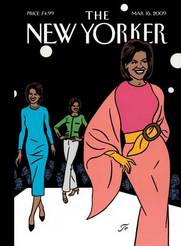Emdashes—Modern Times Between the Lines
The Basics:
About Emdashes | Email us
Ask the Librarians
Best of Emdashes: Hit Parade
A Web Comic: The Wavy Rule
Features & Columns:
Headline Shooter
On the Spot
Looked Into
Sempé Fi: Cover Art
Sempé Fi (On Covers): Elle
Filed under: Sempé Fi Tagged: art, covers, fashion, Floc'h, Michelle Obama, Pollux

Pollux writes:
The Chicago Tribune once asked, “With her gumball pearls, flip hairstyle and chic dresses, could Michelle Obama be the next Jacqueline Kennedy for stylephiles?” The March 16, 2009 issue of The New Yorker is “The Style Issue” and who better to grace its cover than Mrs. Obama, who has quickly become a new fashion icon and a new source of fashion excitement? Michelle Obama is, as one French blog described her, la nouvelle first lady des Etats Unis d’Amérique pour un numéro “The Style Issue.”
That Michelle Obama has chosen to wear the most exciting names in American fashion is an indication of the qualities that also characterize her husband: confidence, self-assurance, elegance, and optimism. Having assumed the mantle of fashion icon, the First Lady has taken advantage of this new role to wear clothes designed not by established, big-name designers, but by rising stars in the world of fashion (Jason Wu, Isabel Toledo, Jimmy Choo), and she has mixed designer clothes with brands like J. Crew.
The choice of Floc’h as cover artist is significant: a practitioner of the precise drawing style known as ligne claire, Floc’h has contributed illustrations to Elle and GQ. The French cartoonist has also created drawings for the Parisian men’s wear shop known as Albert’s on the Rue de Courcelles, and contributed fashion sketches for the Spring-Summer 2009 catalogue for the Breuer house of fashion.
His enormous output (Floc’h has been an illustrator since the late ’70s) includes book cover designs, movie posters, and collections of comics often issued as handsome limited editions bound like portfolios and replete with lavish lithographs. Floc’h’s collaboration with the writer François Rivière, Une trilogie anglaise, which features the adventures of Olivia Sturgess and Sir Francis Albany, are a celebration of British elegance, fashion, and class. And his collaboration with another writer, Jean-Luc Fromental, has produced works like Jamais deux sans trois (“Things Always Happen in Threes”), the story, inspired by the writings of F. Scott Fitzgerald, of a love triangle affecting three chic protagonists.
Floc’h’s past covers for The New Yorker always had a timeless sense of class about them, with their depictions of ski-wear, evening gowns, and well-tailored indoor wear. Floc’h loves to draw clothes, and he draws them precisely.
Floc’h’s “Michelle O” is less a caricature or portrait of Michelle Obama than a portrait of the Michelle Obama Collection, of the fashions inspired by a woman who is of course more than just a manikin. A recent article in The Economist warns of the “Oprah-isation” and “Jackiefication” of a First Lady who is more than a “celebrity mother-cum-clothes-horse” and condemns the media’s obsession with Michelle’s decision, for example, to go bare-armed in public. The article refers to Floc’h’s “cover of the March 16th issue [which] features the first lady strutting on the catwalk in three different outfits (none of them featuring bare arms).” I, too, feel, like the article’s author, that “it would be good to hear a bit more about what Mrs Obama thinks and a lot less about what she wears.”
But if her fashions bring a sense of hope and color (whether those colors be summer sky blue, periwinkle, or volcanic red) to a depressed nation, there is nothing unjust or iniquitous about featuring her on the cover of “The Style Issue.” She has style, and many other qualities besides. Her thoughts and speeches, no doubt, will be the subject of other drawings -not necessarily by the fashion-loving Floc’h, but by other writers and artists who will explore other sides of her character and good sense.
The goal of Floc’h’s cover is to introduce us to the clothes of a new age, and it is a role befitting a French Anglophile who has worked on both sides of the Atlantic, and who is very modern but also very consciously inspired by fashions from earlier decades, and whose output includes as much commercial work as artistic and literary.
The First Lady’s sure-footed and self-assured style of course extends beyond the realm of fashion, but the focus here is on the excitement inspired by her goal to sweep away the dowdiness of the past four decades. Floc’h’s Michelle represents the promise and bright colors of a new era.





Comments
Paul - I didn’t know any of this, about who Floc’h is, thank you! I was vaguely aware that some did or might take a dim view of this cover, but to me, it’s important to remember that it was the style issue. That is, it wasn’t just arbitrarily putting Michelle O into a fashion box; it was taking fashion, which would in any case be the subject of the cover, and taking the opportunity to note the possibility of something more serious being made with it—something represented by her, and her obviously deliberate relationship to fashion.
Thanks, Jonathan! I wasn’t familiar with Floc’h at all before I starting writing this. 99% of the material on him was in French, so I had the great pleasure of translating the article on him in the French Wikipedia into English and making that linkable. Like a lot of French cartoonists, he seems virtually unknown in the US. I’d love to read some of the graphic novels he created with Fromental and Riviere. I think it’s right to remind people that Michelle is more than a body upon which clothes are hung, but I think Floc’h and the New Yorker are quite aware that she’s more than that. Like Jackie, Michelle is a stylish woman, as well as a woman of substance. She can plant a vegetable garden in the White House, for example, and still look good doing it.
I became aware of Floc’h a couple of years ago when I undertook a little survey to see what was being used to illustrate short stories since the Tina Brown era — The New Yorker does a great job of finding or generating apropos juxtapositions. Floc’h is commonly used to illustrate Murakami’s stories, which works great. Once I put the name and the the style together, I learned to welcome his byline — and his work!